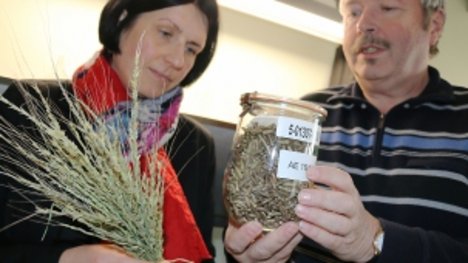Gene bank copied for the EXPO

IPK Gatersleben at the German pavilion
“Feeding the Planet, Energy for Life” is the theme of EXPO 2015 in Milan. And if you want to know what innovative ideas and activities the German states are offering for producing enough healthy food for the world’s population, the Leibniz Institute of Plant Genetics and Crop Plant Research (IPK) in Gatersleben, Saxony-Anhalt, is a model example. That is why a copy of the IPK “gene bank” or crop bank will feature in the presentations at the German pavilion.
Minus 18 ‑ a temperature not reached all winter in Saxony-Anhalt. For the seed samples stored in the gene bank in Gatersleben, this is the ideal temperature for maintaining germinability over decades. Most seed samples are stored in sealed glass jars. Dr. Andreas Börner, head of the Resource Genetics and Reproduction research group, knows exactly where and in which of the walk-in mobile storage units to find specific seed samples, for example if a few grains are to be removed, packaged in small bags and sent off across the world.
The gene bank in Gatersleben receives around 30,000 enquiries each year. “Most come from researchers and breeders working on exactly the question at the centre of EXPO,” says Dr. Sabine Odparlik. She sits on the Institute’s management board and is responsible for management and public relations. “Global climate change is a great challenge. If we are to feed the global population, we need food crops that are resistant to drought and resistant to flooding ‑ if possible both ‑ and are therefore able to survive extreme weather.” Dr. Odparlik explains that the plants must be able to feed themselves even more efficiently but also provide a high yield.
Exactly 151,002 samples of 3,212 species and 776 genuses of grain, feed and vegetable crops, potatoes, pulses, medicinal plants and herbs are stored in the “Genbank” of the IPK. Since the 1920s, the gene bank has collected the seeds of crop plants, most from the temperate zone. The Institute of Plant Genetics and Crop Plant Research was established in 1943 and moved into its current site in Gatersleben, by Quedlinburg, in 1945. The Institute’s gene bank is now one of the largest of its kind in the world.
“We protect species diversity, but we are not a museum,” stresses Sabine Odparlik.
The old varieties are far too low in yield for today’s needs. However, they have characteristics that have been lost in new breeds and could come in useful again in the future ‑ for example following changes in the climate.
Sometimes, certain regional varieties also disappear, in which case the IPK and partners launch projects to help, as they recently did in Ethiopia. “A lack of education and political instability in the recent past had led to agricultural development being neglected. One result of this over the years was the loss of a number of barley varieties that had in fact adapted well to local conditions,” Sabine Odparlik explains. The IPK crop bank has sample of these varieties, collected on research trips in the 1960s and 1970s, and was able to provide specimens. The barley varieties in question are now back in use in Ethiopia on a larger scale and are also being use in breeding. Returning plants in this way is known in the field as “repatriation”.
Sabine Odparlik and Andreas Börner are hoping that the dialogue at the EXPO will help raise awareness, and a new appreciation, of the importance of crop diversity for plant breeding and therefore for feeding the global population.
The German pavilion is a place of communication; the slogan is “Fields of Ideas”. On each field of idea stands a research container that gives visitors an insight into current research projects. One of the containers holds a miniature copy of the IPK crop bank. “Apart from the in-vitro cultures and cryopreservation in liquid nitrogen, the EXPO container does contain many items that should give visitors a realistic impression of our real crop bank,” says Sabine Odparlik. Glasses of specimens are already on the way to the EXPO Agrarfood Park.
One look out of the window at the plots and greenhouses, and there is no need to ask whether these seeds will leave a “gap” in the bank in Gatersleben. “Every ten to fifteen years, we check whether the seed samples in our crop bank are still germinable,” explains Andreas Börner and lifts up white covers to reveal black seeds sprouting pale green shoots. Leaves are growing on the wheat seed in the next storage unit along. “If the seed samples stored are less than 70 percent germinable,” Börner explains, “we restock”. In other words, on the Institute’s 70 hectares of arable land and in its greenhouses, the relevant varieties are cultivated and harvested to provide fresh “copies” of the seeds for the crop bank. “But we are careful!”: the head of the gene bank does not allow even a single seed of the new batch into the bank without a careful “identity check”. To illustrate what he means, Börner takes visitors to his “Totensaal” or “morgue”, as he likes to call his control collection: boxes and glass tubes of grains, seeds and beans; bunches of ears. Comparing these “dead” samples with the new seed ensures that the latter have not come from a different seed that just happens to have germinated in the same patch of ground.
A whole range of such control samples will also be on display in the EXPO container. Overall, explains Sabine Odparlik, the copy of the crop bank should give a striking illustration of the diversity of the crops and their importance to our diet.
Author: Kathrain Graubaum (text/photo)
Caption: Dr. Sabine Odparlik and Dr. Andreas Börner from the Leibniz Institute of Plant Genetics and Crop Plant Research in Gatersleben show us seeds that are being checked for viability.
